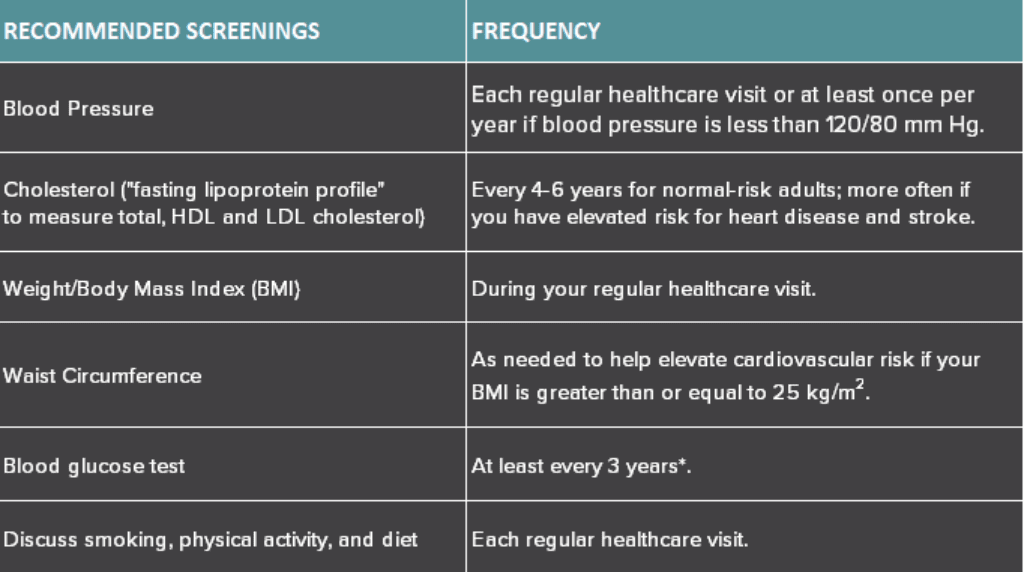
You want to be certain you are doing all you can do to take care of your heart health. Making healthy lifestyle choices and knowing your risk factors are two of the best ways to ensure your heart is well cared for. You may already eat nutritiously or stay active, but how do you know what your risk factors are? This is where your healthcare provider and heart-health screenings can help.

Preventative Screenings
Preventive screenings related to heart-health include blood pressure, cholesterol, body weight, and for some, blood glucose. Of these, blood pressure is one of the most critical because high blood pressure greatly increases your chance of heart attack or stroke, and often has no signs or symptoms. Starting at age 20, the American Heart Association (AHA) recommends having your blood pressure checked at least once per year at your annual physical exam. Although, your doctor may recommend more frequent screenings if your blood pressure is higher than normal.
Your “lipoprotein profile” or cholesterol as it’s more commonly known, should be tested every 4 to 6 years after age 20. Like blood pressure, your doctor may recommend more frequent screenings based on your risk factors.
For those who are overweight and have at least one additional cardiovascular risk factor, your healthcare provider may ask for a blood glucose or “blood sugar” test. High blood glucose puts you at a greater risk for developing prediabetes and type 2 diabetes. When uncontrolled, diabetes can lead to heart disease and stroke.
While it all may sound a little dismaying, having these screenings can have many potential benefits. When you know your risks, you can work with your doctor to make positive changes in your health before serious illness occurs. Moreover, conditions are easier to treat when caught early on. If some of your readings are less than optimal, lifestyle changes and/or medication can often be used to control conditions such as high blood pressure and high cholesterol.
Note: Before visiting the doctor for an annual exam, be sure your chosen physician is in-network according to your health plan. In-network care providers have a contract with your insurance provider to provide care at a set cost. It is typically more expensive to visit a care provider that is out-of-network.

*The American Diabetes Association recommends testing for prediabetes and risk for future diabetes for all people beginning at age 45 years. If tests are normal, it is reasonable to repeat testing at a minimum of 3-year intervals.
(Table from Heart-Health Screenings | American Heart Association)

Does my Health Insurance Cover Screenings?
Most likely yes —the majority of health insurance plans cover preventive services such as screenings, annual physical exams, and vaccinations. To find out what your plan covers, you can request a Summary of Benefits and Coverage. This short and easy to understand document outlines your health plan’s coverage and is available from all health insurance companies and company-sponsored benefit plans. If you would like assistance understanding or clarifying information in your Summary of Benefits and Coverage, reach out to your company benefits broker for assistance.
Your heart-health and well-being are priceless and thankfully, having a check-up likely is too.

The Ultimate Company Vs. Company Step Challenge is Back!
Employee physical and mental health is more important than ever and we find that movement is the best medicine. Involve your team in a fun, active step challenge where you will compete against other Wisconsin organizations and raise money for a great cause.

Living a Heart-Healthy Lifestyle
Supporting a healthy heart and body goes beyond the doctor’s office. What you regularly eat for lunch or snack on has an impact on your heart, as does how active you are throughout the day. Here are some basic guidelines and tips that can help you take care of your heart and feel well for the long-term.
Nutrition: Eating nutritiously doesn't mean giving up all your favorite foods. Learn to make nutritious swaps where you can and find heart-healthy foods you enjoy. A dietary pattern that emphasizes nutrient-rich foods can help you control your weight, cholesterol, and blood pressure.
Nutrient rich foods include:
- A variety of fruits and vegetables
- Whole grains
- Skinless poultry or fish
- Nuts
- Beans (canned or dried)
- Good-for-you oils such as canola, olive, or sunflower
- Low-fat dairy products

Another important factor to be mindful of in a heart-healthy diet is sodium intake. Sodium is a necessary mineral for our bodies that is involved in muscle function and sending nerve impulses. However, consuming too much sodium can put extra strain on your heart and blood vessels and lead to high blood pressure for some.
The AHA (American Heart Association) suggests eating no more than 2,300 milligrams (mg) of sodium per day and ideally limiting your daily intake to 1,500 mg per day for most adults. Cutting back can aid in preventing or reducing high blood pressure.
Preparing your own food from fresh or low-sodium ingredients is one of the top ways to reduce your sodium consumption. Often, premade, prepackaged foods contain high amounts of sodium. Read food labels, especially on premade breads, pizzas, soups, sandwiches, and cured meats, as these can be some of the biggest culprits when it comes to high sodium. Opt for the products with the lowest sodium content.

Physical Activity: Regular physical activity is just as essential as good nutrition when it comes to preventing heart disease and type 2 diabetes. The AHA recommends that adults get at least 150 minutes of moderate-intensity physical activity or 75 minutes of vigorous-intensity physical activity each week for optimal health. Additionally, they recommend strength training at least twice a week.
Any movement that elevates your heart rate and causes you to breathe heavier than you typically would but still allows you to talk is considered moderate intensity. Examples of moderate-intensity activities include riding a bike, pushing a lawn mower, or taking a brisk walk. Activities such as these improve your cardiovascular fitness.
If you haven’t found exercise enjoyable in the past, look for different ways get active. Don’t force yourself to do exercise you greatly dislike or that makes you feel exhausted. Rather, look for activities you would have fun doing. Dance in your living room, go rollerblading, take up gardening, or find a friend to walk with. If you’re just starting to get active, start out slow. Reducing your sitting time or doing light activity has health benefits too and can be a great place to start if your fitness level is low.

Are you looking to take employee healthcare education to the next level? A proper method of communication is key to effective benefit offerings. Choose an uncluttered, engaging medium where you can relay important information to your employees. Whether email or a company intranet, know that choosing a communication method is the most important step you will take in helping your employees and organization thrive.
We communicate with our team using Forsite EXP >>
'Keeping a Pulse on Heart Health' Sources:
